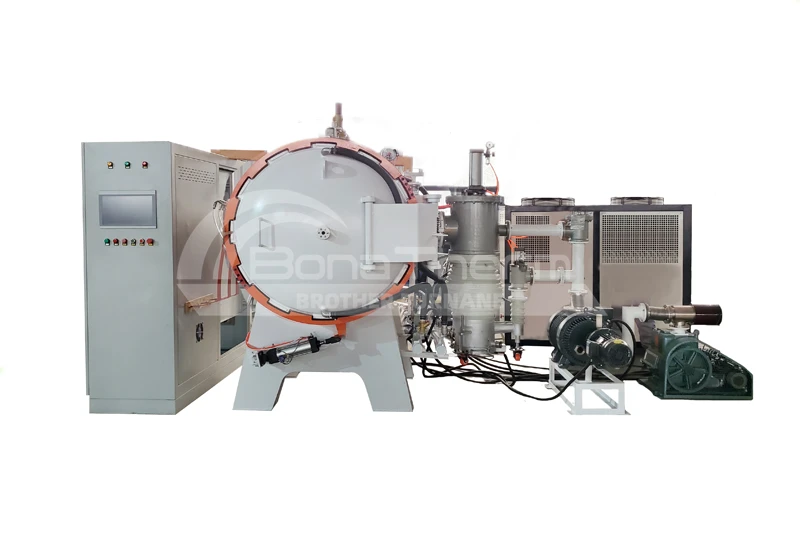seo@bonaregroup.com
Email Us

The vacuum tempering furnace is a device used to temper quenched workpieces in a vacuum environment. It prevents oxidation and decarburization, eliminates internal stresses, and adjusts hardness and toughness. It is suitable for mold steels and stainless steels. It is widely used in aerospace, precision manufacturing, and other fields. Tempering is often used in conjunction with quenching processes.
Starting from the internal structure, we show you the unique design logic of vacuum tempering furnace products:

The heating chamber consists of graphite heating body, graphite soft felt and hard felt.
The heat field can also be heated by high-temperature molybdenum strips and the chamber can be heated by molybdenum foil heat insulation screens, which are free of volatilization, impurities and pollution.

The rear part of the chamber body consists of a high-pressure impeller converter, a multi-stage copper heat exchanger and a high-efficiency air duct guide device.
During air cooling, high-purity nitrogen or argon is introduced. Driven by the high-speed impeller blower, the gas is drawn into the impeller through the high-efficiency copper heat exchanger. After being deflected by the impeller, it is sprayed from the graphite nozzle toward the workpiece through the air duct guide device, ensuring uniform forced cooling of the workpiece.

The material table is composed of graphite pillars, graphite hearth, and Al2O3 spacers on the hearth. This structure can prevent the material tray and graphite hearth from sticking together at high temperatures.

PLC automatic control system, the human-machine interface adopts high-definition touch screen, and has a built-in operating system developed by us.Programmable temperature control instrument PID adjustment.
Focusing on actual scene applications, we will highlight the advantages of vacuum tempering furnace equipment functions for you:
7x10-1pa.
1350℃
1-10bar can be adjusted.
The empty furnace cools from 1150°C to 250°C in less than 7 minutes. (cooling water temperature is less than 35°C)
Upper limit alarm, deviation alarm, automatic stop at the end of program operation, no need for human supervision.
Vacuum tempering furnaces can cover multiple fields and demonstrate their cross-industry adaptability and practical value:






Aiming at the characteristics of various materials, the core advantage of the product is its compatible processing:




Focus on answering common questions to provide users with clear and practical usage guidelines:
A:Typically, no additional cleaning is required (no scale or oil stains). If surface finish adjustment is required, light polishing may be performed. Important components require testing for properties such as hardness and internal stress.
A:Yes, and this is a common combination. After quenching, the workpiece can be directly tempered to avoid exposure to air and oxidation, ensuring the continuity and stability of the heat treatment process. For example, Bona Thermal's Vacuum Quenching Furnace can simultaneously handle quenching, tempering, and annealing processes.
Present performance details with accurate data, intuitively showing the core technical specifications of the vacuum tempering furnace:
| Types | Working Zone (Width x Height x Depth)mm |
Maximum Temperature(℃) | Heating Element | Furnace Capacity(kgs) | Temperature Uniformity(℃) | Power(KW) | Ultimate Vacuum Degree(Pa) |
|---|---|---|---|---|---|---|---|
| BR-QCL-334G | 300X300X450 | 1350 | Graphite | 100 | ±5 | 50 | 7x10-1 |
| BR-QCL-446G | 400X400X600 | 1350 | Graphite | 200 | ±5 | 80 | 7x10-1 |
| BR-QCL-557G | 500X500X700 | 1350 | Graphite | 300 | ±5 | 120 | 7x10-1 |
| BR-QCL-669G | 600X600X900 | 1350 | Graphite | 500 | ±5 | 150 | 7x10-1 |
| BR-QCL-8812G | 800X800X1200 | 1350 | Graphite | 900 | ±5 | 260 | 7x10-1 |
| Types | Working Zone (Width x Height x Depth)mm |
Maximum Temperature(℃) | Heating Element | Furnace Capacity(kgs) | Temperature Uniformity(℃) | Power(KW) | Ultimate Vacuum Degree(Pa) |
|---|---|---|---|---|---|---|---|
| BR-QCL-334M | 300X300X450 | 1350 | Molybdenum foil | 100 | ±5 | 50 | 7x10-1 |
| BR-QCL-446M | 400X400X600 | 1350 | Molybdenum foil | 200 | ±5 | 80 | 7x10-1 |
| BR-QCL-557M | 500X500X700 | 1350 | Molybdenum foil | 300 | ±5 | 120 | 7x10-1 |
| BR-QCL-669M | 600X600X900 | 1350 | Molybdenum foil | 500 | ±5 | 150 | 7x10-1 |
| BR-QCL-8812M | 800X800X1200 | 1350 | Molybdenum foil | 900 | ±5 | 260 | 7x10-1 |
Control of all links from raw materials to finished products:
Stainless steel sheets and high-temperature-resistant alloys are selected, meeting vacuum sealing and load-bearing standards.
Cut raw materials according to design drawings using specialized equipment to ensure dimensional tolerances.
Bends and forms the sheet metal, processing the furnace shell and chamber components with a bending angle accuracy of ±1°.
Lathes are used to process precision components such as flanges and connectors, ensuring surface roughness control.
Weld the furnace body welds, ensuring airtightness on key components, and perform post-weld inspection.
Grinds and trims welded components to ensure a smooth appearance without sharp edges.
Electrostatically sprays the furnace shell and dries it.
Install the vacuum system, heating element, temperature control module, cooling system, and tighten connectors.
Conduct vacuum tests, temperature rise tests, and safety checks.
Internally cushioned with pearl cotton, externally covered with waterproof film and wooden crates, with anti-collision markings and equipment parameter labels.